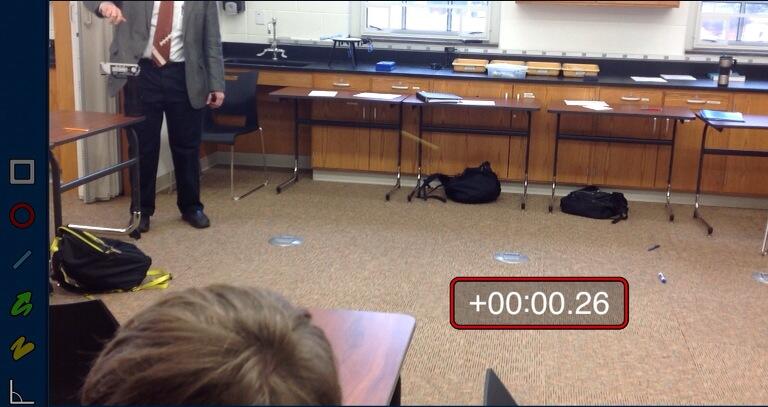 Erik, my physics teaching colleague who also coaches track, showed me a fantastic iOS app. He takes high-speed video of his runners using his iPhone 5, then uses the app "Coach's Eye" to analyze what he sees. The big advantage of Coach's Eye over all other video software that I've seen is the stopwatch overlay. He touched the screen, and a stopwatch accurate to 0.01 s appeared. Then he scrolled to advance the video frame by frame, and the stopwatch synched to the video. The applications for track are obvious; but we both saw how this application could revolutionize motion measurements in the introductory physics lab.
Erik, my physics teaching colleague who also coaches track, showed me a fantastic iOS app. He takes high-speed video of his runners using his iPhone 5, then uses the app "Coach's Eye" to analyze what he sees. The big advantage of Coach's Eye over all other video software that I've seen is the stopwatch overlay. He touched the screen, and a stopwatch accurate to 0.01 s appeared. Then he scrolled to advance the video frame by frame, and the stopwatch synched to the video. The applications for track are obvious; but we both saw how this application could revolutionize motion measurements in the introductory physics lab.
Now, my ipads aren't the latest; they take video at only 30 frames per second, as opposed to the 120 fps that Erik has. So what -- I can still get 0.03 s accuracy, which is plenty for a projectile problem.
THE QUESTION posed as homework to my freshmen: A ball is shot horizontally from a cannon from a cliff above level ground. When the ball's initial speed is doubled, what happens to the time of the ball's flight?
While many students use appropriate facts to find that the time of flight doesn't change, many others do not -- their instinct is that the ball that goes farther and faster must also spend more time in the air. Even those who get the answer right don't really believe.
So I re-pose the question in lab, using a PASCO projectile launcher. I handed out eight ipads, asking the students to open the Coach's Eye app and prepare to take video.* Everyone recorded video of the ball's path.
* Don't worry -- while it took me 20 minutes and several questions to Erik before I was comfortable using the app, my 14 year olds -- all of them, not just the top students -- were ready to shoot video in less than 30 seconds.
Then we clicked "analyze" and placed the stopwatch on the screen, synched to the initial launch. The screenshot above shows the ball in flight, 0.26 s after release -- you can see the ball as a yellow streak in the middle of the frame. (With a 120 fps camera the streak would resolve into a dot.) Everyone advanced the frames until the ball hit the ground, and wrote the stopwatch reading on the board. The average time of flight measured by the class was 0.45 s.
On the board, I carried out the kinematics calculation to predict the height of the launcher -- I got 99 cm. I handed a meterstick to a student, who measured... 98 cm from the floor to the mouth of the launcher. Physics works.
But there's more! I had everyone get in recording position again, and shot the ball with a much faster speed. We again analyzed the video to find the time of flight, writing the results on the board... and the average time was once again 0.45 s. Amazing.
Tomorrow, I'm going to follow up with one more problem, as suggested by my colleague Alex. I'll ask on a quiz, if the height of the launcher were doubled, would the time of flight double, less than double, or more than double? Of course they'll all say the time should double to 0.90 s. But then I'll pile two desks on top of one another, fire the projectile while everyone records video, analyze the video... and we'll see what physics says.
Notes about the app: It costs $4.99 for the app, plus another $4.99 in-app purchase to get the stopwatch tool. Worth every penny, at least for a single class ipad. And the Coach's Eye developers, whoever they are, haven't given me a dime for this review. If they'd like to change that sorry state of affairs, they can contact me through Woodberry Forest School. :-)
GCJ



No comments:
Post a Comment